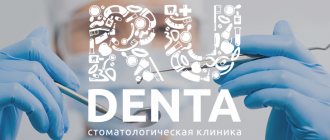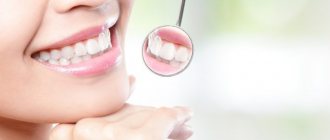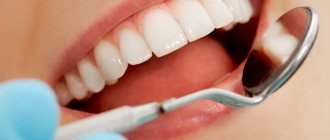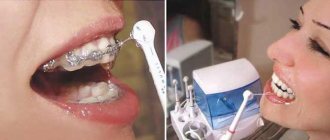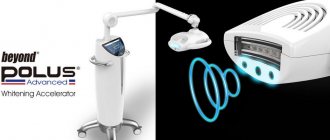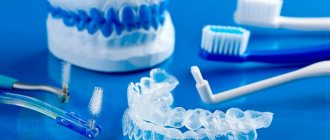Author of the article:
Soldatova Lyudmila Nikolaevna
Candidate of Medical Sciences, Professor of the Department of Clinical Dentistry of the St. Petersburg Medical and Social Institute, Chief Physician of the Alfa-Dent Dental Clinic, St. Petersburg
Cold lamp teeth whitening is one of the most modern ways to lighten enamel. The procedure is carried out using a special LED lamp with cold light.
This method is often confused with whitening with a conventional incandescent lamp, which heats the enamel, which is unsafe for the teeth, as it leads to their cracking, and also causes a lot of unpleasant sensations during the process itself. It is no wonder that patients are often distrustful of lamp bleaching.
The impact of an LED lamp is very different from a standard one; Let's figure out how effective and safe it is, and whether we should be guided by old stereotypes.
This is one of the photobleaching methods
Photo whitening allows you to radically transform your smile in just one visit to the dentist. The technology is also called “light”, since during its implementation the doctor acts on the tooth pigment through lamps emitting cold or hot light.
The principle of removing pigment from enamel is similar in all photobleaching methods. It is assumed that a gel with hydrogen peroxide or urea (reagent) and light (catalyst) will be used. Under the influence of a light lamp, the gel releases active oxygen, which penetrates deep into the tissue and removes pigment.
The essence of lamp whitening
It cannot be said that in this procedure, whitening occurs thanks to the light produced by the LED lamp. The bottom line is that light is only a catalyst for a chemical reaction between the reagent and the pigments that are inside the enamel and are responsible for its color.
In order to neutralize the yellow tint, a special gel based on hydrogen peroxide is applied to the teeth. Light exposure to this substance activates oxygen, which penetrates the tooth tissue and oxidizes pigments. Thus, light rays stimulate the chemical process, making the procedure safer and faster.
The main advantage of this method is that the light from the LED lamp practically does not heat the enamel, and therefore does not harm it.
Carried out using halogen lamps
Cold teeth whitening involves the use of a gel activated by halogen lamps, the radiation of which is passed through special filters. As a result, the teeth are exposed to high-intensity, cool blue light.
Halogen lamps have the least negative effect on enamel
It is believed that halogen lamps have the least negative effect on the enamel and do not cause pain during and after the procedure. During operation, they do not heat tissues, as do ultraviolet and LED devices used, for example, for ZOOM technology, which also belongs to the category of photo-bleaching. However, the same “ZOOM” has its own advantages, because the developer has created a gel for these lamps, which contains components that strengthen and reduce the increased sensitivity of the enamel.
Cold light is light that does not have ultraviolet or infrared radiation; its temperature is approximately 37 ° C (almost the same as that of the human body). Due to this temperature regime, the procedure is as comfortable and painless as possible for the patient.
Contraindications
You should not resort to whitening with an LED lamp in the following cases:
- high sensitivity of teeth;
- defects on enamel;
- pregnancy or lactation period;
- intolerance to the active components that make up the gel;
- fixed dentures, crowns or a large number of fillings;
- The procedure is also not recommended for children under 16 years of age;
- caries, periodontitis and other diseases.
In the latter case, the ban is temporary, since the procedure can be carried out after you have treated your teeth.
Gentle on enamel and gums, does not cause pain
Experts say that teeth whitening with cold light eliminates the possibility of injury, overheating and overdrying of hard tissues, as well as increased enamel sensitivity after the procedure. When carrying out manipulations there is no risk of burns or irritation of the mucous membrane.
Cold whitening is a gentle method
“I’ve been wanting to try cold whitening for a long time. True, because of the name, I was afraid that the cold would set my teeth in the process, but it turned out that this was not the case at all. During the procedure, I very carefully monitored the sensations that arose: when the gel was applied, I felt a slight tingling sensation, but I did not have any direct pain or cramps. Everything is tolerant and acceptable! On the first day, of course, my teeth ached, there’s no way around it, but less than with chemical whitening, which I did before. By the second day I already felt completely fine.”
Viki_Niki, review from otzovik.com
How to save the result
Once you've gotten the whiteness you wanted, don't forget that your teeth now need more careful care. For a week, it is best to follow a clear (white) diet, the essence of which is to exclude coloring or very hot foods. It is also better to reduce your cigarette consumption.
In addition, professional products from the ASEPTA series for oral care will help you. They will prevent the appearance of yellow plaque, caries and other troubles, for example, ASEPTA Sensitive toothpaste will help reduce tooth sensitivity after the procedure. In the future, you can use ASEPTA PLUS Remineralization or Gentle Whitening toothpaste to maintain a snow-white and healthy smile.
Sources:
- Report on determining/confirming the preventive properties of toothpaste “ASEPTA PLUS” GENTLE WHITENING” Author: doctor-researcher A.A. Leontyev, head Department of Preventive Dentistry, Doctor of Medical Sciences, Professor S.B. Ulitovsky First St. Petersburg State Medical University named after. acad. I.P. Pavlova, Department of Preventive Dentistry
- Report on the determination/confirmation of the preventive properties of personal oral hygiene products “ASEPTA PLUS” Remineralization doctor-researcher A.A. Leontyev, head Department of Preventive Dentistry, Doctor of Medical Sciences, Professor S.B. Ulitovsky First St. Petersburg State Medical University named after. acad. I.P. Pavlova, Department of Preventive Dentistry
- Clinical studies of antisensitive toothpaste “Asepta Sensitive” (A.A. Leontyev, O.V. Kalinina, S.B. Ulitovsky) A.A. LEONTIEV, dentist O.V. KALININA, dentist S.B. ULITOVSKY, Doctor of Medical Sciences, Prof. Department of Therapeutic Dentistry, St. Petersburg State Medical University named after. acad. I.P. Pavlova
- Report on determining/confirming the preventive properties of toothpaste “ASEPTA PLUS” COFFEE and TOBACCO Author: doctor-researcher A.A. Leontyev, head Department of Preventive Dentistry, Doctor of Medical Sciences, Professor S.B. Ulitovsky. First St. Petersburg State Medical University named after. acad. I.P. Pavlova, Department of Preventive Dentistry
Will not cope with hypoplasia and fluorosis
The technology will not be effective against non-carious lesions and stains that affect the aesthetics of the smile: hypoplasia, fluorosis, wedge-shaped defect. Especially if the pathologies are severe.
Are any of the professional whitening methods effective for the listed defects? Researchers claim that some types of hypoplasia, mild fluorosis and even tetracycline teeth are best treated with ZOOM technology. But most often, such patients are still offered to install veneers, lumineers and crowns (if the teeth are severely damaged), which, in addition to adding aesthetics to the smile, help protect the enamel from external influences, destruction and caries.
The technology will not be effective against fluorosis
Allows you to lighten teeth by 6–10 shades
Teeth whitening without heat or laser is safer than with it. However, the effect of using this technology will not be so impressive: not 8–12, but 6–10 tones. The maximum positive result can be achieved if darkening or yellowing of the enamel was caused by smoking, consumption of food and drinks with dyes, or age-related changes.
Some doctors do not advise teeth whitening with cold light if the enamel has a natural gray tint, because then the maximum that can be achieved will be only 2-3 tones.
A smile can be lightened by 6–10 tones
Modern methods
There are several lightening techniques in dentistry. Some of them have long been fully tested in our country, others are just gaining their clients.
Cold lightening techniques are also among the popular procedures. Let's look at the features of the most popular of them.
Beyond Polus
In Russia, this technique appeared relatively recently, but is already the most popular. Almost 80% of all patients choose it for the following reasons:
- high whitening result – 12 shades;
- session duration is only 30 minutes;
- the effect of the procedure lasts for 2 years;
- point exposure allows you to lighten individual areas on the teeth or individual units;
- the adverse effect of the system on enamel is reduced to a minimum, thanks to the built-in filter system.
This technique is suitable for people with too dark tooth surfaces and high enamel sensitivity.
Luma Cool
A popular procedure in European countries, but very limited use in Russia. It is the safest and only patented technology in the world that allows you to use not a halogen lamp (as is customary), but a diode lamp during the procedure.
Its advantages include the following characteristics:
- whitening by 8-10 tones;
- session time – 25-30 minutes;
- Guaranteed retention of results - 1 year.
Amazing White
Is a new development. Activation of chemical processes occurs due to the LED lamp. The advantages are:
- whitening by 7-8 tones;
- procedure time – 45 minutes;
- the result lasts up to 2 years.
All of the listed cold lightening techniques are painless and safe for the patient and do not harm the teeth. Their only drawback is their high cost.
The importance of the procedure for determining hygienic indices and the methods used.
This publication provides detailed information about intra-canal teeth whitening.
Here https://zubovv.ru/krasota-i-uxod/otbelivanie/domashnee/opalescense.html you will find reviews about Opalescence teeth whitening.
Cold teeth whitening techniques
Amazing White: this is one of the most popular and safest methods today, allowing you to lighten the enamel by 6-10 tones. At the same time, dentists who use the technique in their practice assure that you will get a natural color, and there is no risk of unnatural whiteness.
Amazing White is one of the most popular whitening methods
Beyond Polus: allows you to whiten teeth in different clinical cases, since the device designed for the procedure has several operating modes (soft, normal and intensive). According to a number of studies2, Beyond lamps emit minimal heat compared to similar devices from other manufacturers. Beyond International also offers patients the opportunity to purchase a halogen lamp for home use, but more details about this and much more can be found in the feature article on the website.
Beyond lamps produce minimal heat
Luma-Arch (“Luma Arch”): using this method you can lighten the enamel by 6-8 tones. To do this, you will only need to make 1 visit to the dentist and spend about 30 minutes (the teeth are lightened in three approaches of 8 minutes each). The method is not as popular in Russia as the others that were listed earlier.
Notice
: Undefined variable: post_id in
/home/c/ch75405/public_html/wp-content/themes/UltraSmile/single-item.php
on line
45 Notice
: Undefined variable: full in
/home/c/ch75405/public_html/wp-content /themes/UltraSmile/single-item.php
on line
46
Rate this article:
( 1 ratings, average: 5.00 out of 5)
whitening
- Androsenko N.I. Comparative characteristics of teeth whitening methods in therapeutic dentistry // Bulletin of medical Internet conferences. – 2020.
- Lutskaya I.K. Current state of the problem of teeth whitening // International reviews: clinical practice and health. – 2020.
Expert “Teeth whitening with cold light is one of the safest technologies. But this does not negate careful preparation for the procedure, including professional oral hygiene, strengthening the enamel through fluoridation and remineralization, and the use of special pastes that reduce the sensitivity of hard tissues. It is also necessary to exclude contraindications: age under 18 years, multiple caries, acute inflammation of the gums, oncology, a large number of fillings or the presence of artificial crowns in the smile area.” Dental hygienist Victoria Nikolaevna Kashaeva
Consulting specialist
Boyko Natalya Grigorievna
Doctor rating: 9.3 out of 10 (4) Specialization: Dentist-therapist Experience: 12 years
Why does tooth enamel darken?
To get the most out of lamp whitening, you need to understand the causes of darkening of tooth enamel. In most cases, it is enough to eliminate the negative impact and clean the teeth so that the color of the teeth becomes natural again.
Dentin has a dark shade, which shines through a thin layer of enamel. A fair question arises: how does it happen that dentin darkens if the enamel is strong and can protect the tooth from many negative factors?
The reason is quite simple. It lies in the universal love for solid foods and sour drinks. Seeds, nuts, lemonades and other similar products contribute to the deformation of the upper layer of teeth. Through scratches and chips, pigments easily penetrate into the tooth tissue, staining the dentin.
The main factors influencing the color of teeth:
- The most popular reason is the consumption of foods that contain large amounts of coloring substances. These can be the following things: cranberries, blueberries, beets, strawberries, various candies and sodas, coffee, strong tea and much more. If this is the reason for the darkening of your teeth, then careful hygiene and periodic professional cleaning (once or twice a year) will help.
- Change • Change in enamel color is common in smokers. The main problem here is the tar that is in the cigarette. Together with smoke, they fall on the surface of the teeth and settle in the form of a dark plaque. Gradually, this sediment destroys tooth enamel, which can lead to caries and more serious diseases. In addition, smoking also has a negative impact on your gums. The best option in this case would be to quit smoking completely. If this is not possible for you, try to reduce your cigarette consumption to a minimum and pay more attention to oral hygiene.
- The tooth may darken due to injury, which led to damage to the neurovascular bundle. In this case, consultation with a specialist is necessary. Until the cause is eliminated, whitening will not help lighten the tooth.
- The shade may change due to the removal of the nerve; the darkening may not appear immediately, but also requires the intervention of a specialist.
- Filling a canal can lead to staining of the enamel; it all depends on the material used to fill the hole.
- Progressive caries is an advanced case of ordinary caries. The fact is that if such damage is not eliminated, small black spots will increase, destroying the enamel and then the dentin.
- Teeth may have congenital characteristics that are in no way related to caries or other damage. They can differ in structure, tone, shape, and so on. In some cases, it is possible to change their color only with the help of special overlays - veneers.
- Excess fluoride in the water you drink can lead to fluorosis. At the beginning of the disease, dark spots or chalky streaks appear on the teeth. The progression of the disease leads to the destruction of enamel and then dentin. Whitening such teeth is not possible until you get rid of fluorosis.
- Taking tetracycline antibiotics during pregnancy can negatively affect the condition of the baby's teeth.
Comments
There is a filling on the front tooth, will it be whitened using the methods you listed?
Valya (06/08/2020 at 01:15) Reply to comment
- Dear Valya, fillings and artificial crowns cannot be whitened by any of the methods existing today. If you want to whiten the enamel, then the filling will need to be changed so that it matches the color of the new shade of the teeth.
Editorial staff of the portal UltraSmile.ru (06/13/2020 at 09:15) Reply to comment
Is it possible to do cold bleaching immediately after air flow?
Laura (06/27/2020 at 01:24 pm) Reply to comment
- No, you need to wait at least 7–10 days: during this period you need to use special pastes and remineralizing compounds.
Editorial staff of the portal UltraSmile.ru (07/03/2020 at 09:47) Reply to comment
Will they give me an anesthetic injection before bleaching, otherwise I’m afraid...
Zverev S. (07/13/2020 at 15:47) Reply to comment
- Injection anesthesia is not used for such a procedure, but the gums and soft tissues will be treated with a special protective gel that reduces sensitivity and the likelihood of irritation of the mucous membrane.
Editorial staff of the portal UltraSmile.ru (07/17/2020 at 09:08) Reply to comment
Write your comment Cancel reply
Advice from Dr. Zubastik
The desire to have a beautiful smile is natural. There are many ways in dentistry that help to do this:
- chemical bleaching;
- laser cleansing;
- Air Flow technique.
Is UV Whitening Your Solution? Fine. But first consult your doctor: is this method suitable for you? Will it cause negative consequences? Are there any contraindications for which other methods are recommended? If the doctor has no doubts, sign up for ultraviolet whitening.
I wish you a snow-white smile! But don’t forget: whitening is a cosmetic procedure, not a medical one. First of all, take care of your dental health, whitening comes second. Be healthy, see you again!
Tags: Beyond, zoom, whitening, ultraviolet whitening, photo whitening
About the author: Dr. Zubastik
Typically, a toothache begins to subside on the way to the clinic and finally goes away after 10 minutes of sitting in line to see the dentist.
- Related Posts
- Dental implantation: everything about the operation and its consequences is brief and clear
- Top 15 questions about braces and the same number of expert answers
- Endo-teeth whitening: who is recommended for a new miracle procedure?
« Previous entry


